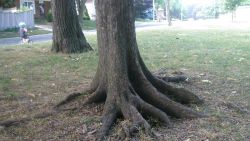Toronto Media Co-op
Local Independent News
Hickory Highlands: Vanished forests and climate change in the suburbs
from Knowing the Land is Resistance
http://knowingtheland.wordpress.com
It’s mid-July 2012, and each month of the year so far has broken the record for heat and dryness. In Southern Ontario, climate change is increasingly a present reality. It is the context in which we act, and its effects will only get more pronounced as time passes. As we explored the relic forests of Hamilton’s West Mountain, we’ve been talking about what kinds of possibilities for freedom and wildness we can find within a changing climate. What can we learn in the forested corners of this suburban neighbourhood about community resiliency and supporting the health of the wild?
We’re walking South on Upper Paradise from the Scenic Drive escarpment stairs beside the neatly trimmed and weeded lawns, scorched crispy and brown by the current drought. Many trees have been dropping leaves in the dry heat. We pause in front of one lawn scattered with leaves of a familiar but surprising five-leaflet shape. We look up at the tree, and are excited to see the long strips of flaky bark confirming it’s a Shagbark Hickory.
It’s a rare treat to see a Shagbark growing in the open like this, yet its shape doesn’t look like what we’d expect an open grown, front-yard tree to be. It’s tall, with more than twenty feet to the first branch, and has a narrow canopy. A huge Red Oak, only two feet away from the Hickory, has its first branch at level with the roof of the house, with no sign of cutting or pruning. “They look like forest trees,” we realize. Looking around us, we see many more trees like this lining the big front-lawns of these suburban homes: relics from an ancient forest still quietly remembered in the forms of these survivors.
As we appreciate the sad beauty of these trees, we wonder about the Hickory-Oak association that they suggest. Was this the forest type that used to grow on the West Mountain? We’ve read about the greedy slaughter of the ancient Hickory forests – one billion board feet of Bitternut shipped to England, three-hundred million board feet of Shagbark cut annually. This destruction is still relatively recent history, and the construction of these suburbs far more recent still. And yet it can be hard to see through to what was once here, to imagine this land a different way. We decide to search for other traces of the lost Hickory forest in South-West Hamilton’s suburban sprawl.
Read More at https://knowingtheland.wordpress.com/2012/07/17/hickory-highlands-vanish...
About the poster
The site for the Toronto local of The Media Co-op has been archived and will no longer be updated. Please visit the main Media Co-op website to learn more about the organization.
